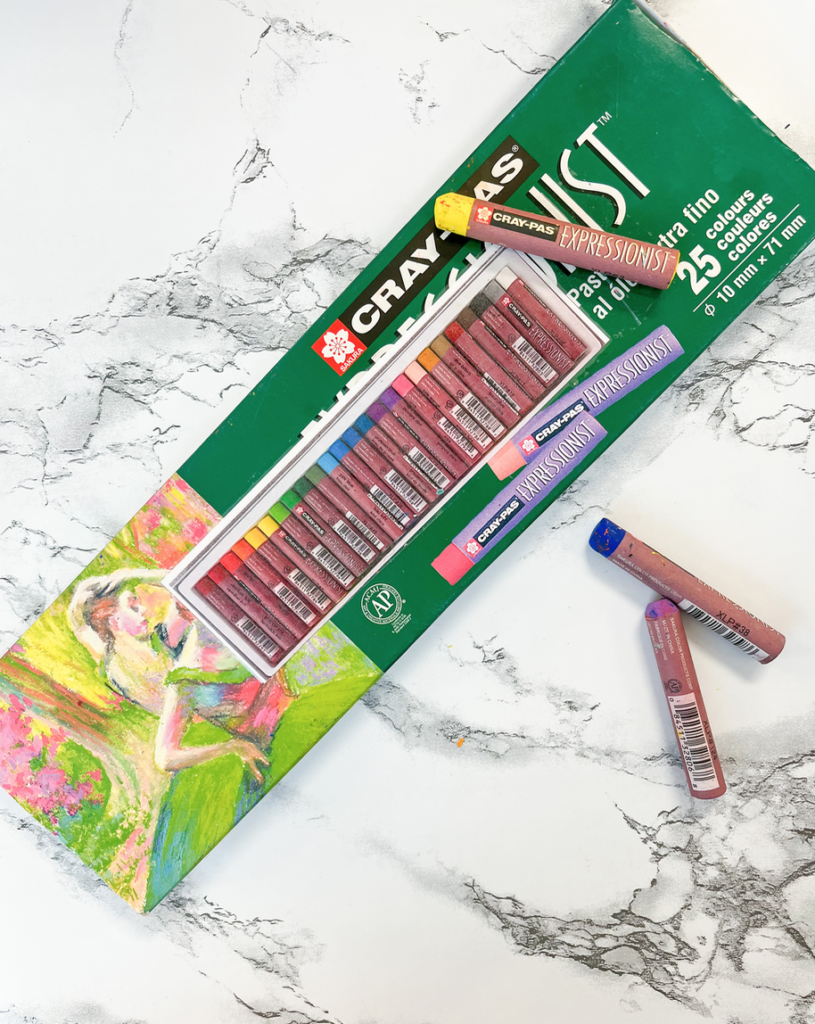*Disclosure: This post contains affiliate links. That means that if you click on the link and make a purchase, I will get a small commission at no additional cost to you.
Using oil pastels in my art room is a win-win for my students and I. The kids feel like they are using a more sophisticated version of a crayon and I get to teach them color matching and mark making in a sneaky way!
Oil pastels are so vibrant and fun to use but they can also be a little intimidating if you have never used them with an entire class before (or even if you have). They can be a bit messy and sometimes students struggle with using them properly. The following 5 tips are ones I have very helpful in using oil pastels successfully in my classroom.
- Never blend with your fingers.
- Sandwich oil pastels to blend.
- Use an image on the box.
- Never use black.
- Always double check the floor!
Blended with fingers pic
- Never blend with your finger.
Okay, so this is a personal belief of mine that might be controversial for most art teachers. Whether using graphite, charcoal, or oil pastel, I always try to encourage my students to use neat mark making and use the material itself to blend rather than a finger or a tissue. Students are so tempted to blend using their finger but let me tell you why I discourage it…
When students blend with a tissue or their finger, the edges of their shapes tend to get blurred so they no longer look crisp and clean. As a result, this technique can tend to make students’ drawings look messy and have visible fingerprints. In addition, blending with your finger or a tissue dilutes the value. If a medium-dark value is applied and then blended out with a finger, the value becomes more of a medium value than medium-dark. This is a problem because students (especially middle schoolers) tend to not develop their dark values enough anyways so their drawings tend to lack contrast. When students blend a value out to a lighter value, they very rarely think to go back in and deepen those darkest areas. This pattern transfers to oil pastel as well.
Sandwiches colors to blend pic
- Sandwich your colors.
Based on the paragraph above you’d probably think I’m against blending in general. However, that is not the case. I just think there are better ways to do it. I like to tell my students to make an oil pastel sandwich when mixing two colors. I tell them to first lay down a light layer of the most prominent color, then the color that you want to mix with it, and then top it with another layer of the prominent color. If you use small circular motions when you do this, the color will be blended but not muddy.

- Use pictures to keep your boxes organized.
One thing I’m really happy I did before I had my classes bust into new boxes of oil pastels was taking a photo of the inside of the pastel box. I then printed out this image and taped it on the top of the box with clear packing tape so that the students know which order to keep their oil pastels in. Believe it or not, being a neat freak and organization lover is not why I do this. I add the image to the box so that the kids can identify right away if they are missing a color that needs to be replaced.
Now, I’m not naive to the fact that 80% of the boxes do not end up back in that order at the end of every class. However, it also helps when I have a student helper go through the boxes of oil pastels at the end of the unit to organize them. They can use this image to help them make sure there are no duplicates, missing colors, or anything in the wrong order.
Picture of cherry with and without black.
- Never use black.
I remember the first time I heard about not using black in an artwork was when I was in high school learning how to oil paint. At first it sent me into a panic but now I teach the concept to all of my students. The problem with using black is that it tends to flatten everything out and be a little too harsh in even the darkest areas. Also, there is really no true “black” in the world. It is simply a really really dark green, blue, or another color. So I teach my students how to make a black “substitute” which is a mixture of dark brown and dark blue. Using this combo helps establish a very dark value without looking flat.
Most students are tempted to also use black to add to a color when wanting to create a shadow. For instance, if they were drawing a red cherry, they’d be tempted to mix black into their red for the cherry’s shadow. However, what works much better is one of two things. Either the artist can add the blue/brown mixture to the base color (in this case red) or they can add the complimentary color to the base color. Complimentary colors can be found by looking at what color is across from the color you are using on the color wheel. If we go back to the cherry example, you’d want to add green to the area that has a shadow and then layer red back on top of it. Here’s a picture to show you how much of a difference it makes!
Crushed oil pastel
5. Always check the floor!
Oil pastels are a PAIN to clean up off the floor- especially if they get stepped on. I try to end class a few minutes early when using oil pastels so I can ask students to look around for any that have fallen on the ground. If students find any, I take them and put them in a container so that I can use them as replacements when we need more of a particular color. If you do tend to get oil pastel on the floor, consider using some dish soap on a wet towel. I know it sounds weird but dish detergent has properties in it that help cut the grease and oil on dirty dishes. Since oil pastels are oil based, the soap helps break down the oil and cleans the floor rather than just smearing it around. Just make sure to rinse and dry the area well when you are done so that no one slips on a soapy floor.
Overall, I believe oil pastels are totally worth the mess and intimidation so definitely consider giving them a shot!
If you want an awesome oil pastel unit to do with your middle or high schoolers, check out this unit in my TPT shop.
Here are the oil pastels I use in my classroom and love!
Hope this helps.
Happy teaching!
Christine


